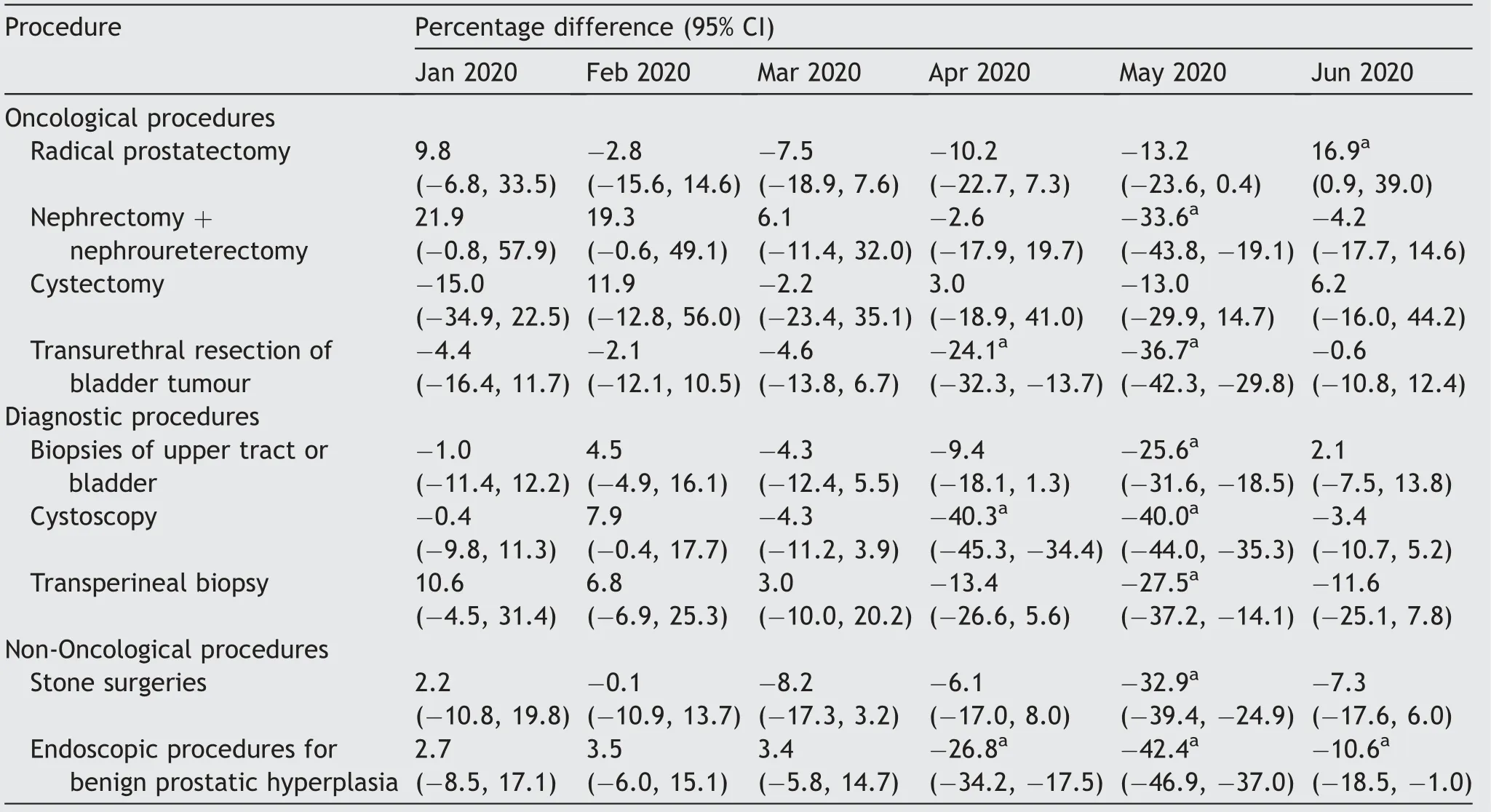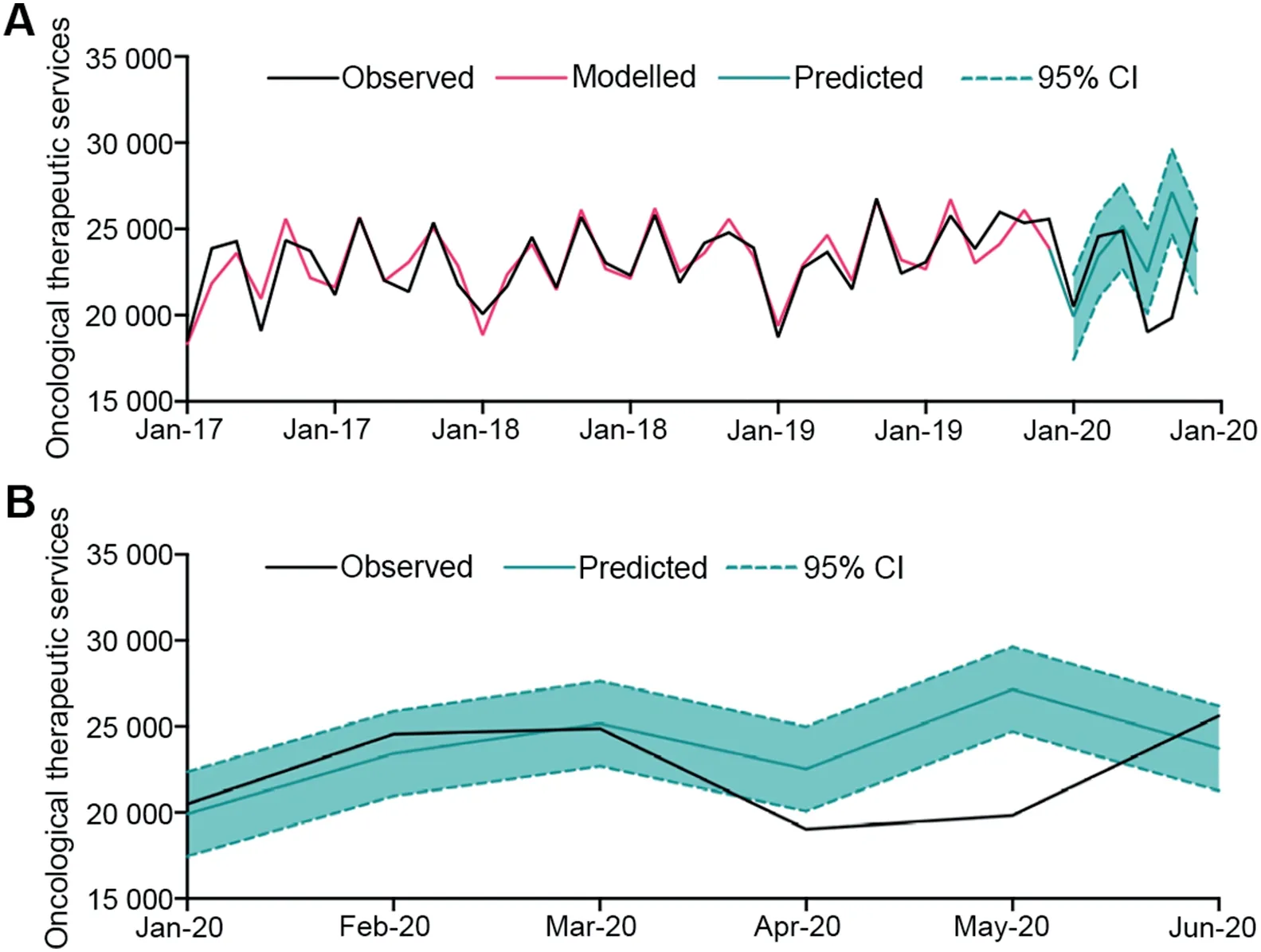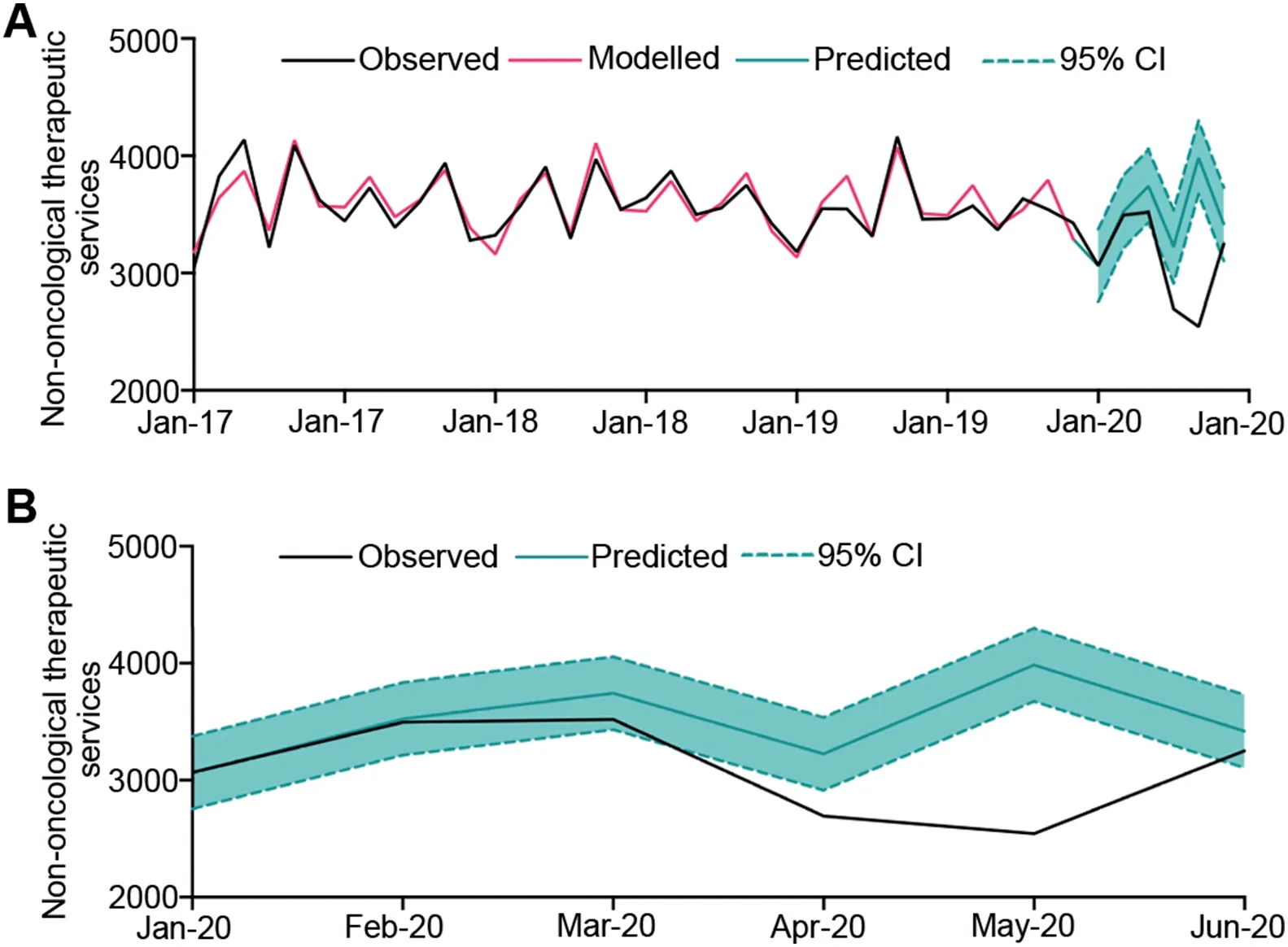The impact of the coronavirus disease 2019 pandemic on elective urological procedures in Australia
Athul John , Mustafa Mian , Suhashaan Sreedharan ,Arman A.Kahokehr c
a Adelaide Medical School, University of Adelaide, Adelaide, SA, Australia
b Melbourne Medical School, University of Melbourne, St Albans, Melbourne, VIC, Australia
c Flinders University, Bedford Park, SA, Australia
KEYWORDS Coronavirus;Urology;Corona virus disease;Elective procedures
Abstract Objective: To investigate the changes in elective private urological procedures in Australia during the coronavirus disease 2019 pandemic.Methods: Data were extracted from publicly available datasets from Medicare Benefits Schedule using item numbers assigned to each commonly performed urological intervention.These procedures were divided into three groups:Oncological therapeutic,diagnostic,and non-oncological therapeutic procedures.A smoothing model,based on the historic procedure numbers from 2017 to 2019,was used to forecast monthly number of procedures performed in each category between January 2020 and June 2020.These forecasted models were compared with reported figures.Results: A total of 108 169 procedures were performed between January 2020 and June 2020 based onthe MedicareBenefitsSchedule item numbers listed.There wasa significantreduction(percentage change)in total procedures performed in April 2020(-22.6%,95%confidence interval[CI]:-28.7%to-15.4%)and May 2020(-33.2%,95%CI:-37.5%to-28.3%).There was a significant reduction in oncological therapeutic,non-oncological therapeutic,and diagnostic procedures performed in April 2020 and May 2020(p<0.05).These numbers did not include procedures performed in public sector.Conclusion: There was a significant reduction in total urological procedures(including diagnostic,oncological,and non-oncological)performed in months of April 2020 and May 2020 during time of federal restrictions.Both public and private healthcare sectors need to be supported in the upcoming months to prevent further delays in treatment and poorer clinical outcomes.
1.Introduction
Coronavirus disease 2019(COVID-19)pandemic has a major impact on the world economy and healthcare.In Australia,there have been approximately 27 000 cases reported with about 900 deaths as of October 2020 alone [1].As the number of cases increased in early 2020,there were various strategies implemented by the Australian federal and state governments to minimize transmission rates and redirect resources towards management of COVID-19 patients.One of these nationwide strategies was the suspension of nonurgent elective surgery on the 25th of March, 2020.Only category 1 (admission desirable within 30 days) and urgent category 2 (admission desirable within 90 days) procedures were allowed.This allowed for increased capacity of the health systems to deal with the pandemic by protecting the supply of intensive care unit (ICU) and high dependency unit (HDU) beds, ventilators, and personal protective equipment (PPE).However, this strategy had major implications on the delivery of elective urological procedures.These restrictions were later lifted on the May 15th after successful suppression of COVID-19 transmission in most parts of Australia.The impact of this critical period during the pandemic on elective urological procedures in Australia is unknown.
Australia relies on both public and private sectors to serve the needs of the population.Provision of healthcare in Australia is financially regulated by Medicare.Medicare Benefits Schedule (MBS) lists the range of urological procedures that attract a Medicare rebate based on a unique item code.The frequency of use of each item codes is collected and publicly available online.The item codes are claimed in private hospitals, private patients in public hospitals, and fee for service public hospitals.Consequently, this database not only allows an accurate assessment of the impact of provision of private urological procedures, but also can be used as a surrogate marker of the public healthcare system.
This study aims to explore the overall impact of COVID-19 on the provision of elective urological surgical procedures during the early months of the pandemic.
2.Methods
2.1.Data source and extraction
The Australian MBS database provides information on the utilisation of government subsidised medical services including diagnostic procedures and investigations, and therapeutic interventions [2].Monthly data for all urological procedures,between January 2017 and June 2020,were extracted.Analysis of procedures was performed for total urological procedures, and then stratified according to service type as follows: (1) Oncological therapeutic procedures,(2)diagnostic procedures,and(3)non-oncological therapeutic procedures.A description of individual procedures under each service type is provided in Appendix 1.As all data were publicly available,ethical approval was not required.
2.2.Statistical analysis
Triple exponential smoothing (Holt-Winters) is a commonly used forecasting technique used to analyse interrupted time series data.Triple exponential smoothing accounts for average values (level), trend over time and seasonal or holiday related changes [3].In the present study, an additive triple exponential smoothing model was built using monthly procedures between January 2017 and December 2019 in order to predict monthly procedures between January 2020 and June 2020 with a 95% confidence interval (CI) (p<0.05).Observed monthly procedures between January 2020 and June 2020 were compared with predicted monthly procedures over the same time period to calculate absolute and percentage residual differences (RD).Models were developed for (1) total urological procedures, (2) oncological therapeutic procedures, (3) diagnostic procedures, and (4)non-oncological therapeutic procedures.All statistical analyses were performed using SPSS version 22 (IBM SPSS,Amronk, NY, USA) and LKS-CHART Forecasting Tool (St.Michael’s Hospital, Toronto, ON, Canada).
3.Results
3.1.Total urological procedures
Within the limits of MBS database, a total of 108 169 urological procedures were performed between January 2020 and June 2020.There were no statistically significant differences between observed and predicted total procedures in January 2020, February 2020, and March 2020.In April 2020, there were 4233 fewer procedures performed compared to forecasted figures (RD: -4233, -22.6%, 95%CI: -28.7 to -15.4).In May 2020, 7668 fewer procedures were performed (RD: -7668, -33.2%, 95% CI: -37.5 to-28.3).There were no statistically significant differences between observed and predicted total procedures in June 2020 (Fig.1, Table 1).
3.2.Oncological therapeutic procedures
A total of 13 441 oncological therapeutic procedures were performed between January 2020 and June 2020.There were no statistically significant differences between observed and predicted oncological therapeutic procedures in January 2020, February 2020, and March 2020.In April 2020, there were 350 fewer oncological therapeutic procedures performed compared to forecasted figures (RD:-350, -15.5%, 95% CI: -23.9 to -5.2).In May 2020, 734 fewer oncological therapeutic procedures were performed(RD:-734,-27.0%,95%CI:-33.1 to-19.7).There were no statistically significant differences between observed and predicted oncological therapeutic procedures in June 2020(Fig.2, Table 1).On subgroup analysis, there was asignificant reduction in the number of transurethral resection of bladder tumour procedures performed in the April and May compared to the model.The number of nephrectomy and nephroureterectomy performed in May was also reduced compared to the model (Table 2).

Figure 1 Total urological procedures in Australia between January 2017 and June 2020.(A) Observed total procedures between January 2017 and June 2020, modelled total procedures between January 2017 and December 2019, and predicted (with 95% CI) total procedures between January 2020 and June 2020.(B) Observed and predicted (with 95% CI) total procedures between January 2020 and June 2020.CI, confidence interval.
3.3.Diagnostic procedures
A total of 76 163 diagnostic procedures were performed between January 2020 and June 2020.There were no statistically significant differences between observed and predicted oncological diagnostic procedures in January 2020, February 2020, and March 2020.In April 2020, there were 3291 fewer diagnostic procedures performed compared to forecasted figures (RD: -3291, -25.0%, 95%CI: -30.9 to -18.0).In May 2020, 5430 fewer diagnostic procedures were performed (RD: -5430, -33.3%, 95% CI:-37.6 to -28.3).There were no statistically significant differences between observed and predicted oncological diagnostic procedures in June 2020(Fig.3 and Table 1).On subgroup analysis, there was a significant reduction in number of cystoscopies performed in April and May compared to the model.Transperineal biopsy procedures were also performed less frequently in May compared to the model (Table 2).
3.4.Non-oncological therapeutic procedures
A total of 18 565 non-oncological therapeutic procedures were performed between January 2020 and June 2020.There were no statistically significant differences between observed and predicted non-oncological therapeutic procedures in January 2020,February 2020,and March 2020.In April 2020, there were 532 fewer non-oncological therapeutic procedures performed compared to forecasted figures(RD:-532,-16.5%,95%CI:-23.8%to-7.6%).In May 2020,1442 fewer procedures were performed(RD:-1,442,-36.2%,95%CI:-40.8%to-30.8%).There were no statistically significantdifferences between observed and predicted non-oncological therapeutic procedures in June 2020(Fig.4 and Table 1).There was an overall reduction in number of endoscopic procedures performed for benign prostatic hyperplasia in April and May compared to the model(Table 2).

Table 1 Monthly absolute and percentage differences between observed and predicted number of total procedures, oncological therapeutic procedures, diagnostic procedures, and non-oncological therapeutic procedures in Australia.
4.Discussion
The COVID-19 pandemic has significantly impacted the provision of urological procedures in Australia.Our study has shown a statistically significant decrease in the number of oncological, diagnostic, and non-oncological procedures performed during the country wide COVID-19 restrictions.Although the figures are likely to reflect the private sector,it can also be used as a surrogate marker for public services.This reduced number of procedures in the private sector will likely have various implications for the public,ultimately leading to an increase in demand for the public and private healthcare system in the upcoming months.To our knowledge, this is the first study incorporating a national database to assess the impact of COVID-19 on the provision of elective urology procedures in Australia during the pandemic.We hope the findings will contribute to the existing data related to COVID-19 and assist governments and regulators to formulate evidence-based strategies during the recovery phase of the pandemic.
There are several studies published in literature exploring the effect of COVID-19 on the provision of urological procedures as highlighted by the scoping review published by Qu et al.[4].Although not captured in this study, Madanelo et al.[5] assessed emergency presentations during the pandemic and showed a reduction in urological presentations with an associated decrease in admissions.Marandino and colleagues [6] performed a cross-sectional survey of urologists worldwide exploring the influence of COVID-19 on stone management that most experts were opting for elective readmission for stone management.Amparore et al.[7] explored the forecasted future burden of urologists.They concluded that in outpatient setting, the burden will mainly involve prostate biopsies and elective procedures for a benign condition.For inpatient setting, the procedures performed will involve lower-risk prostate and renal cancer,non-obstructing stone disease, and benign prostatic hyperplasia [7].
Several factors have resulted in the decreased number of procedures performed during the times of COVID-19 restrictions.Majority of the reported reductions can be explained by restrictions placed by the government resulting in a major overhaul and reprioritization of procedures.This reprioritization of procedures for urological procedures in Australia was based on the recommendations and guidelines provided by Urological Society of Australia and New Zealand(USANZ)[8].These guidelines highlighted the procedures which warranted surgical intervention during the period of restrictions [9].Another potential reason which needs to be considered is the patient’s financial status.According to Australian Bureau of Statistics, the seasonally adjusted unemployment rate during May 2020rose to 7.1% compared to 5.2% in the previous year [10].There was also a reduction in the number of hospital private insurance memberships by 28 546(0.2%)in the second quarter of 2020 compared to the first quarter[11].The loss of income and private health insurance are likely to lead to underutilization of the private healthcare sector.In addition, the decreased availability of ICU and HDU beds for major oncological surgeries performed can also contribute to the reduction in numbers.Nevertheless, the overall underutilization of private sector for urological procedures during these times will lead to an increase in demand for both public and private health services in Australia in the upcoming months.
The number of oncological and diagnostic procedures performed in the private sector by urologists has experienced a significant reduction in the months of April and May in 2020 in context of federal and state restrictions,particularly transurethral resection of bladder tumour procedures.This may contribute to future treatment delays, leading to the increased incidence of clinically advanced urological malignancies in the upcoming months.Despite these reduction in numbers, there are multiple studies that have concluded the majority of uro-oncological surgeries can safely be deferred 2-3 months without impacting the long-term cancer-specific or overall survival[12,13].Notable exceptions are muscle-invasive bladder cancer, high-grade upper tract urothelial cell cancer, large renal cell cancer (RCC) (T3), testicular cancer, and penile cancer [12,13].This formed the basis of USANZ guideline which prioritises orchidectomy, RCC>7 cm or complicated with venous thrombus, upper tract malignancy, high-risk prostate cancer (select Gleason score 8-10), cystectomy for muscle invasive bladder cancers (MIBC), and surveillance cystoscopy for high-risk non-muscle-invasive bladder cancer during the restrictions.Diagnostic investigations for macroscopic hematuria with features of abnormal radiology or cytology, and prostate biopsies for Prostate Imaging-Reporting and Data System 4/5 on prior magnetic resonance imaging were also prioritized.Although a delay of 2-3 months are unlikely to affect the oncological outcomes, a further delay has been shown to affect outcomes for some urological malignancies.Surgical delay in MIBC greater than 12 weeks, 5-6 months delay in T2 RCC, delay greater than 120 days for high-grade upper tract urothelial cancer are all associated with a negative impact on the overall survival [14-16].This is in contrast to patients’perspective, where a recent survey of urological patients conducted in Italy showed that majority of patients preferred to delay the surgery and considered the risk of COVID-19 more harmful than delaying surgery [17].Nevertheless, further delays need to be avoided as the healthcare facilities attempt to cope with the increase in demand for these services during recovery phase.It is reassuring to note the increase in procedure numbers, particularly for radical prostatectomy, after ease of federal restrictions in our subgroup analysis(Table 2).Adequate funding needs to be dedicated towards these services in both public and private sectors to facilitate this increase in demand and prevent further delays in treatment.

Table 2 Percentage differences between observed and predicted number of urological procedures in Australia during the first wave of the COVID-19 pandemic.
Delay in non-oncological procedures was expected and inevitable given these procedures tend to be of lower priority with a few notable exceptions.Although theseprocedures have a lower impact on individual survival and mortality, it still has a significant implication on an individual’s quality-adjusted life years which are also important to consider when assessing the impact of a reduction of procedures on the population.Given the significant reduction, these procedures will likely contribute to the increased burden and workload in the future as postulated by Amparore and colleagues [7].

Figure 2 Oncological therapeutic procedures in Australia between January 2017 and June 2020.(A)Observed oncological therapeutic procedures between January 2017 and June 2020,modelled oncological therapeutic procedures between January 2017 and December 2019, and predicted (with 95% CI) oncological therapeutic procedures between January 2020 and June 2020.(B) Observed and predicted (with 95% CI) oncological therapeutic procedures between January 2020 and June 2020.CI, confidence interval.

Figure 3 Diagnostic procedures in Australia between January 2017 and June 2020.(A) Observed diagnostic procedures between January 2017 and June 2020, modelled oncological diagnostic procedures between January 2017 and December 2019, and predicted (with 95% CI) diagnostic procedures between January 2020 and June 2020.(B) Observed and predicted (with 95% CI) diagnostic procedures between January 2020 and June 2020.CI, confidence interval.

Figure 4 Non-oncological therapeutic procedures in Australia between January 2017 and June 2020.(A) Observed non-oncological therapeutic procedures between January 2017 and June 2020, modelled non-oncological therapeutic procedures between January 2017 and December 2019,and predicted(with 95%CI)non-oncological therapeutic procedures between January 2020 and June 2020.(B)Observed and predicted(with 95% CI) non-oncological therapeutic procedures between January 2020 and June 2020.CI, confidence interval.
This study analysed the effect of COVID-19 on elective urological procedures at a national level using robust modelling methods, however, these findings should be interpreted in the context of some limitations.Data presented here do not represent all urological procedures in Australia.The MBS does not include procedures provided to inpatients at public hospitals or services that are entirely private and do not attract a Medicare rebate.Furthermore,services qualifying for benefit under the Department of Veterans’ Affairs, Work Cover, or the Transport Accident Commission are not included.Based on 2017 elective surgical admissions data, self-funded and department of veteran affair funded patients accounted for approximately 13.7%of non-public patients.Public patients accounted for 31% of all elective surgical admission in 2017 [18].In addition,some item numbers can be classified as diagnostic and non-oncological therapeutic procedures particularly relevant for pyeloscopy involving removal of single stone and biopsy.Unfortunately, there is no clear way to determine the indication for these procedures to further subcategorise them.Additionally in the subgroup analysis, the low procedure count for infrequently performed surgeries like cystectomy, may not be sufficient to detect reduction in number of procedures performed using our modelling.Furthermore, the impact of COVID-19 pandemic on Australian urological practices also goes beyond procedure numbers.The change in number and impact of the paradigm shift towards telehealth and telemedicine also needs to be assessed [19].Despite these limitations, we believe these findings are still largely reflective of the overall impact of COVID-19 on elective private urological procedures in Australia.
5.Conclusion
The COVID-19 restrictions have a major impact on the provision of private elective urological procedures in Australia with a reduction in a number of the oncological,diagnostic, non-oncological, and overall number of procedures performed during April and May 2020.Although majority of oncological and cancer screening diagnostic cases can safely be delayed by 2 months, ongoing surveillance of procedures provided needs to be monitored to develop strategies to minimise further delays caused by these restrictions.Both public and private healthcare sectors need to be supported and funded to cope with the upcoming increase in demand for procedures to prevent further delays in treatment and poorer clinical outcomes.
Author contributions
Study design: Athul John, Mustafa Mian, Subhashaan Sreedharan.
Data acquisition: Mustafa Mian, Subhashaan Sreedharan,Athul John.
Data analysis: Mustafa Mian, Subhashaan Sreedharan.
Drafting of manuscript: Athul John, Mustafa Mian, Subhashaan Sreedharan, Arman A.Kahokehr.
Critical revision of the manuscript: Athul John, Arman A.Kahokehr.
Conflicts of interest
The authors declare no conflict of interest.
Appendix A.Supplementary data
Supplementary data to this article can be found online at https://doi.org/10.1016/j.ajur.2021.07.001.
 Asian Journal of Urology2022年1期
Asian Journal of Urology2022年1期
- Asian Journal of Urology的其它文章
- Chromophobe renal cell carcinoma: Novel molecular insights and clinicopathologic updates
- The role of preoperative dutasteride in reducing bleeding during transurethral resection of the prostate: A systematic review and meta-analysis of randomized controlled trials
- Efficacy and safety of desmopressin on frequency and urgency in female patients with overactive bladder and nocturia,current clinical features and outcomes: A systematic review
- Efficacy of a combination of dutasteride,tadalafil,and solifenacin in the treatment of previously unsuccessful patients
- Associations between IL-1RN variable number of tandem repeat, IL-1β(-511)and IL-1β (+3954) gene polymorphisms and urolithiasis in Uighur children of China
- Ultrasound heterogeneity as an indicator of testicular salvage in testicular torsion: A single center experience
